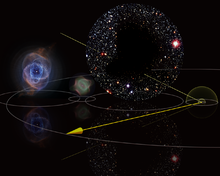- 1 E+40 m³
-
To help compare the orders of magnitude of different volumes, here is a list of volumes between 1040 m3 and 1050 m³. See also volumes or capacities of other orders of magnitude and corresponding lengths.
- Smaller volumes than 1 E40 m³
1 E+40 m³ to 1 E+43 m³
- 1.1×1041 m³ = daily increase in volume of the Cat's Eye Nebula[1]
1 E+43 m³ to 1 E+46 m³
- 4×1043 m³ = annual increase in volume of the Cat's Eye Nebula[1]
- 2×1045 m³ = approximate volume of the Stingray Nebula[2]
1 E+46 m³ to 1 E+49 m³
Planetary nebula typically have volumes in this range.
- 2.7×1046 m³ = volume of the Cat's Eye Nebula[1]
- 5.5×1046 m³ = the volume of a Bok globule like Barnard 68[3][4]
- 4.4×1047 m³ = the volume of a Bok globule one light year across[3][4]
- 8.47×1047 m³ = 1 cubic light-year
- ~1.7×1048m³ = volume of the Oort Cloud, assuming a radius of 50000 AU
1 E+49 m³ and larger
- 2.93799894×1049 m³ = 1 cubic parsec
- Larger volumes than 1 E50 m³
Notes
- ^ a b c 4*Pi*R^3/3; core radius R = distance times sin(angular diameter / 2 ) = 0.2 light year.Distance = 3.3 ± 0.9 kly; angular diameter = 20 arcseconds; expands 10 milliarcseconds per year.(Reed et al. 1999)
- ^ R=0.08 light years; (4*Pi/3)*R^3=1.86×1045 m³
- ^ a b Michael Szpir (May-June 2001). "Bart Bok's Black Blobs". American Scientist. Archived from the original on 2003-06-29. http://web.archive.org/web/20030629033609/http://www.americanscientist.org/template/AssetDetail/assetid/14678. Retrieved 2008-11-19. "Bok globules such as Barnard 68 are only about half a light-year across and weigh in at about two solar masses"
- ^ a b their size varies: a globule one quarter light year in radius has 5.5×1046 m³, one a half light year in radius has 4.4×1047 m³, one a light year in radius has 3.5×1048 m³
References
- Reed, Darren S.; Balick, Bruce; Hajian, Arsen R.; Klayton, Tracy L.; Giovanardi, Stefano; Casertano, Stefano; Panagia, Nino; Terzian, Yervant (1999). "Hubble Space Telescope Measurements of the Expansion of NGC 6543: Parallax Distance and Nebular Evolution". Astronomical Journal 118 (5): 2430–2441. Bibcode 1999AJ....118.2430R. doi:10.1086/301091.
Orders of magnitude for volume SI derived unit cubic metre, from base unit metre Conversion of units for volume 1 E-36 m3 = 100 Mm³ 100 Gm³ 1,000 m³ = 1 dam3 1,000 km3 1,000 Mm3 1,000 Gm3 10,000,000 m³ = 10 hm3 10,000,000 km3 10,000,000 Mm3 1 E+50 m3 Categories:
Wikimedia Foundation. 2010.

